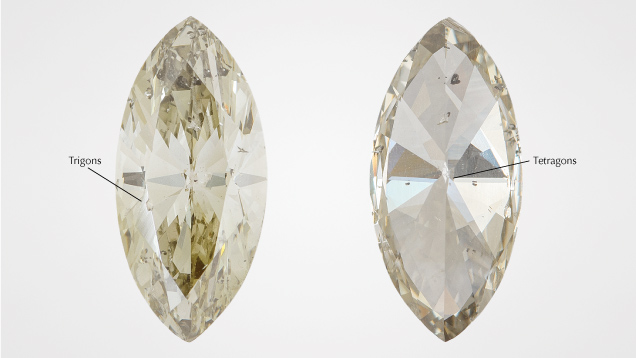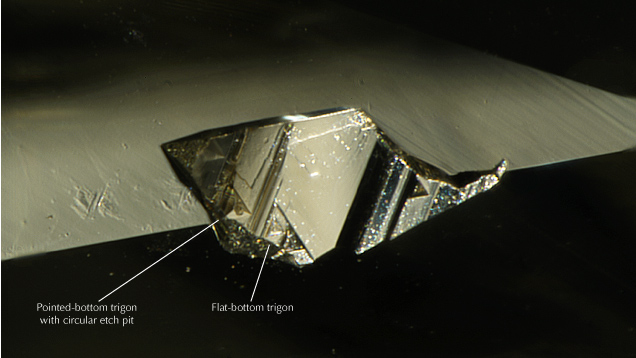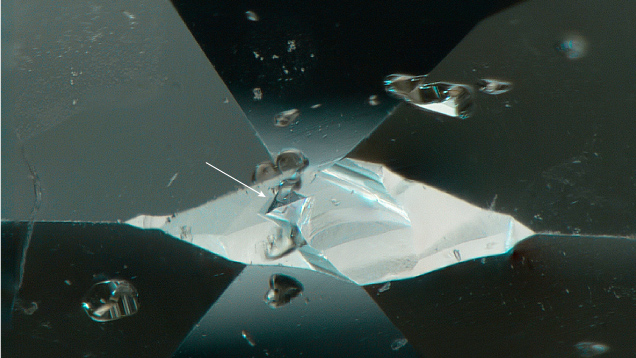Etch Features Reveal the Morphology of Diamond

Natural monocrystalline diamonds formed in the earth’s mantle have two major growth forms: octahedron and cube. It has been suggested that diamond growth habit depends on multiple factors, including crystallization temperature, growth rate, and the degree of carbon supersaturation in the diamond-forming fluids (J.W. Harris et al., “Morphology of monocrystalline diamond and its inclusions,” Reviews in Mineralogy and Geochemistry, Vol. 88, No. 1, 2022, pp. 119–166). If a diamond forms under changing conditions, it might not have a regular octahedral or cubic morphology but a combination of both. In some cases, diamonds grow without any well-defined crystal faces and are referred to as “irregular diamonds” (see examples in R. Tappert and M.C. Tappert, Diamonds in Nature: A Guide to Rough Diamonds, Springer-Verlag, Berlin, 2011, p. 28). While octahedral or cubic faces cannot always be identified visually in irregular diamonds, the morphology can be inferred by etch features left on the diamond by fluids in the mantle or during kimberlite eruption. Trigons and tetragons are the most common of these etch features—restricted to octahedral and cubic crystal faces, respectively.


The Carlsbad laboratory recently examined a 2.00 ct Fancy brown-greenish yellow diamond with both trigons and tetragons on its surface (figure 1). The trigons were located within a small indented natural near the table facet, while the tetragons were preserved within an indented natural at the culet (figures 2 and 3). Co-occurring trigons and tetragons are very uncommon and indicate an irregular morphology, characterized by both octahedral and cubic growth.
This stone was identified as a chameleon diamond. For such a classification, the diamond must include a green color component, show phosphorescence to short-wave UV, and change from a greenish color to a yellow or orange color with gentle heating or when kept in the dark for an extended period (C.M. Breeding et al., “Natural-color green diamonds: A beautiful conundrum,” Spring 2018 G&G, pp. 2–27). These diamonds typically have a broad visible absorption band centered at approximately 480 nm and are referred to as “480 nm band diamonds.” A study on rough yellow diamonds from Canada showed that all of those colored by the 480 nm absorption band have irregular morphology (M.Y. Lai et al., “Yellow diamonds with colourless cores – evidence for episodic diamond growth beneath Chidliak and the Ekati mine, Canada,” Mineralogy and Petrology, Vol. 114, 2020, pp. 91–103), suggesting that diamonds with the 480 nm absorption band may form under changing conditions in the mantle.
Trigons on diamond have two major morphologies: either a flat bottom or a pointed bottom (pyramidal). The type of trigon is primarily dependent on the temperature and pressure at the position where diamond dissolution occurs, as well as on the carbon dioxide and water contents in the fluid that etches diamonds. Experimental work indicates that fluids with higher carbon dioxide content tend to produce pointed-bottom rather than flat-bottom trigons (Y. Fedortchouk, “A new approach to understanding diamond surface features based on a review of experimental and natural diamond studies,” Earth-Science Reviews, Vol. 193, 2019, pp. 45–65). Both forms of trigons were observed on the chameleon diamond we examined, as well as a circular etch pit overprinting a pointed-bottom trigon (figure 2). Unlike pointed-bottom trigons, circular pits are typically created by fluids with low carbon dioxide contents, indicating a late-stage etching event after the formation of the trigon.
The combination of surface features provides clues for the morphology of diamonds in rough form, as well as the interactions between diamonds and fluids throughout their journey from mantle residence to the earth’s surface.
.jpg)


